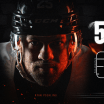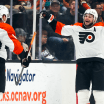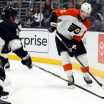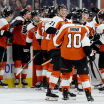Things change fast in the National Hockey League. Last offseason, the Flyers were coming off a seeming breakthrough 2019-20 campaign and fell one win short of reaching the Eastern Conference Final. This offseason, after the team got off to an 11-4-3 start through February despite not playing particularly well, collapsing in March and going on to miss the playoffs, there's a lot of uncertainty.
Who is a lock to return for the 2021-22 season? Who is looking for a bounce-back year after, for whatever individual and/or teamwide reasons, falling short of expectations in 2020-21? Who might be in a different city come opening night?
The truth of the matter, at least right now, is that there are very few complete "untouchables" on the roster, although some scenarios are more plausible than others. Ultimately, much will depend on the circumstances and opportunities that present before the start of next season. It will also, of course, be dependent on how the team's salary cap management strategy takes form.
Prior to the NHL Expansion Draft, Entry Draft and the start of free agency, we will publish a six-part series taking stock of the roster the Flyers take into the offseason. We will look at the following categories of players: young core (age 25 and younger), veteran core (age 26 and older), comeback trail (players aiming for a bounceback season in 2021-22), rookie hopefuls and veteran role players. Following the 2021 NHL Entry Draft, we will look at players for whom the CHL/AHL age eligibility rule applies (Tyson Foerster, Zayde Wisdom, and potentially the Flyers' 2021 first-round pick).
Let's start with the "young core" group: players of age 25 or younger who are already established regulars in the Flyers' lineup and whose role on the team is well-defined. Note: goaltender Carter Hart fits within this category but he will lead off the "Comeback Trail" segment of the series.
Offseason Inventory: The Young Core
Flyers contributor Bill Meltzer takes offseason inventory of the roster, evaluating 'the young core' group of skaters in Philly
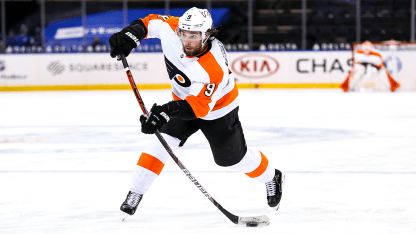
IVAN PROVOROV
Age: 24
Contract Status: Signed through 2024-25 ($6.75 million AAV)
Provorov is a three-time winner of the Barry Ashbee Trophy, including the 2019-20 and 2020-21 seasons. He has yet to miss a game in the National Hockey League, having dressed in all 371 regular season games and 22 playoff matches the Flyers have played since he debuted. He's reached double-digit goals twice in his career, and annually leads the team in all-situation ice time.
As with most of the roster, however, Provorov's 2020-21 season did not match the standards of consistency he set the prior year (or, for that matter, in 2017-18). How much of it had to do with Provorov playing with a revolving door of defense partners in 2020-21 following the early retirement of Matt Niskanen and how much of it was the player himself is tough to fully parse.
What is fair to say that Provorov entered the 2020-21 season with very lofty expectations on his shoulders. The Flyers No. 1 defenseman did not have a poor season but he also did not regularly elevate his game to an elite or near-elite level on either side of the puck. Provorov is relied on to be a tone-setter and a significantly positive difference-maker not only at even strength but also on the penalty kill and the power play (whether on the first or second unit).
Entering the 2021 offseason, one of the Flyers' primary goals is to find a right-side partner for Provorov on the team's top defensive pairing. The inability to fill void left by Niskanen's departure -- in terms of chemistry with Provorov, ice-time and matchup slotting of all three defense pairings, and a steadying presence in times of adversity -- was one of the factors that negatively impacted the club in 2020-21.
Ideally, the acquisition could form a long-running partnership with Provorov. An alternative route would be to try for a shorter-term "chemistry fit" in combination with other moves designed to help the team bring back down a goal against average that ranked 7th in the NHL in 2019-20 but sank to the bottom of the league this past season.
JOEL FARABEE
Age: 21
Contract Status: Entry-level contract (RFA after 2021-22)
The Flyers' 2018 first-round pick is one of the few players on the team who took a definitive forward step in 2020-21. A little stronger and more assertive in his second NHL season, Farabee hit the 20-goal mark while posting 38 points in 55 games. He missed one game due to COVID-19 protocols.
Farabee was not slump-proof in his second NHL season, but he was very good offensively in January and February and surged again late in the season. He's always had good two-way upside. He took further strides in his 200-foot game in 2020-21. The youngster hit a rough patch for a couple weeks while the team as a whole was fragile and breakdown-prone, but he pulled through it.
During the 2020-21 season, Farabee had three power play goals and four power play assists. He averaged 2:00 of power play time ice time per game; 11th on the team but a figure that is likely to increase next season. He also averaged 1:20 of penalty killing time in his second NHL season. Konecny showed versatility in being deployed either on left wing or the right side as needed.
Next offseason, Farabee will become a first-time restricted free agent. He will not have arbitration rights. Whether he ultimately signs a bridge deal or a long-term extension (which would require a more substantial raise) is a question that will take shape largely based on what he achieves in 2021-22.
TRAVIS KONECNY
Age: 24
Contract Status: Signed through 2024-25 ($5.5 million AAV)
A first-time NHL All-Star Game participant and the Flyers' leading regular season scorer in 2019-20, Konecny scored 24 goals in three straight seasons heading into this past season.
Konecny had a hard time during the 2020 Stanley Cup playoffs in the Bubble in Toronto in attempting to pick up where he left off at the time of the leaguewide pause. He went goalless with seven assists in 16 postseason games.
Unfortunately, Konecny followed it up with a somewhat disappointing 2020-21 season by his standards. The winger who was one of the Flyers' players who missed time in February due to a bout with COVID-19 and had been a one-game healthy scratch in late January, dressed in 50 of 56 games. He posted 11 goals and 34 points during the season, with just seven tallies coming at even strength.
When Konecny is at his best, he buzzes around the net, hounds the puck on the forecheck and is an irritating, pesky presence that gets under opponents' skin. He is less effective when he plays along the perimeter and settles for shots above and outside the the right faceoff dot.
From a puck possession analytics standpoint, Konecny had a solid 2020-21 season with a 55.1 percent Corsi at even strength (55.6 percent in 2019-20) and he also cut down on his turnovers (15 charged giveaways in 50 games after being charged with 47 giveaways in 66 games in 2019-20. This is a double-edged sword, however.
While he was turning over fewer pucks this past season, Konecny was also less assertive and creative with the puck than he was previously. He was less inclined to shoot the puck during the 2020-21 season than in prior seasons. He'd had a rather rough 2020 playoffs in terms of turnovers (11 charged giveaways in 16 games, combined with his scoring difficulties) and seemed a little gun-shy at times this past year.
Konecny was something of a defensive liability his first couple seasons after his initial arrival the NHL. He worked to improve in areas such as decision-making with the puck in the danger-zones of the ice, weak-side coverages in his own end and not leaving the defensive zone too early. While he'll likely never be a Selke Trophy candidate or part of a penalty killing rotation, Konecny has generally become at least an adequate two-way player.
Most likely, Konecny will remain entrenched in the upper part of the Flyers' lineup and power play personnel entering next season. However, he is the type of player in whom other teams have interest -- young, long-term contract, proven track record but coming off a bit of a down year.
TRAVIS SANHEIM
Age: 25
Contract Status: Arbitration-eligible RFA ($3.25 million AAV on expiring deal)
Sanheim signed a two-year bridge deal as a first-time restricted free agent in the summer of 2019. He had an overall strong 2019-20 season and uneven 2020 Stanley Cup playoff (strong in the round robin and portions of the Montreal series, struggled against the New York Islanders).
This past season, Sanheim had a roller coaster campaign. The positive is that he actually did fine from an analytics standpoint: 54.1 percent Corsi, 51.5 percent Fenwick Close, positive differential in expected goals despite a minus-22 traditional plus-minus rating. He was particularly effective in joining the play up-ice and prolonging puck possession for Philadelphia.
The negative: Sanheim and Phil Myers, both as a pairing and individually, struggled mightily at times during the season especially during the team's fateful swoon in March. Sanheim struggled at times with gap management, net-front containment, turnovers under forechecking pressure and unforced turnovers (40 charged giveaways). He took on a penalty killing role in 2019-20 for the first time in his career and showed promise, but was not as effective this year amid teamwide PK struggles.
With Sanheim, much of it boils down to a matter of perspective. If someone is looking for him to be a punishing physical presence because he is 6-foot-4 and 200-plus pounds, disappointment is likely. Conversely, if one is looking for a defenseman with the coveted combination of size, mobility and ability to help move the puck up the ice, Sanheim is an above-average second pair NHL defenseman.
From an offensive standpoint, Sanheim was a top point producer by defenseman standards in the Western Hockey League and a well-above average one in the American Hockey League. In the NHL, he's periodically played on the second power play unit but did not regularly do so in 2020-21. In the past, he's flirted with double-digit goals a couple times but has yet to hit that mark. He posted 35 points in 2018-19; his career best to date.
Sanheim averaged a career-high 21:53 of ice time in 2020-21. Presently, although they were only briefly paired together this past season (they were a regular second-half pairing in 2018-19), Sanheim is the Flyers de facto No. 2 defenseman behind only Provorov. Even if the team upgrades the blueline this offseason to find a high-caliber partner for Provorov, Sanheim will still be relied upon heavily next season and is likely to average 20-plus minutes of ice time.
It is not impossible that Sanheim (or Myers) could be made available under certain trade scenarios this offseason. However, he is not a player whom the Flyers will actively seek to trade despite his arbitration-eligible restricted free agent status. More likely, the team and the Sanheim camp will seek to strike a new bridge deal and he will remain part of the top-three or top-four in ice time among the team's defense corps.








